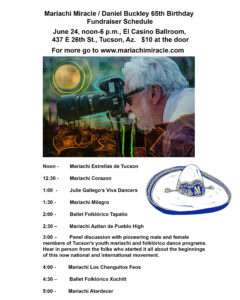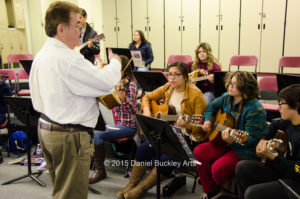CLICK IMAGE TO ENLARGE
So why a panel discussion in the middle of a mariachi/folklórico celebration?
Primarily because the current generation of youth mariachi and folklórico dancers members, families, boards, etc. have little idea how such groups came about.
 Given how many such groups now dominate the Tucson landscape it’s hard to imagine a time – let along a long one – when there was only one youth mariachi. It’s hard to remember that young women weren’t part of the youth mariachi scene for nearly two decades.
Given how many such groups now dominate the Tucson landscape it’s hard to imagine a time – let along a long one – when there was only one youth mariachi. It’s hard to remember that young women weren’t part of the youth mariachi scene for nearly two decades.
In this panel discussion as part of the Mariachi Miracle fundraiser those attending will get to know some of the male and female youth mariachi and folklórico pioneers of Tucson. They’ll get to hear stories of those early days. They’ll come away with an appreciation of how these artforms evolved into the vibrant movement it has become.
So who will be taking part in the discussion?
Gilbert Velez was one of the very first members of Tucson’s first youth mariachi – Los Changuitos Feos (the ugly little monkeys). Velez has been a leader in mariachi education and is an internationally renowned instructor in Kenpo Martial Arts. Los Changuitos Feos formed in 1964 and continues to this day. It is the group that started the practice of investing earnings from performances and using the money to send the young musicians to college via its scholarship fund. The current crop of Los Changuitos Feos will perform immediately following the panel discussion.
In 1982 an important youth mariachi group was formed called Mariachi Nuevo. The group was created by the parents of Reuben and Richard Carranza. Richard Carranza would go on to found Mariachi Aztlán de Pueblo High School. What is of foremost significance about Mariachi Nuevo is that it was the first Tucson group to incorporate young female musicians. Representing Mariachi Nuevo are female pioneers Angelina Ruiz and Julie Maldonado.
A decade after Mariachi Nuevo formed, Richard Carranza created what would become the first curriculum-based mariachi program in the Tucson Unified School District – Mariachi Aztlán de Pueblo High School. In many ways Aztlán was the catalyst to the renaissance of Pueblo High and serves as the group young mariachis aspire to join. Representing its early days are Yvonne Elias Herran and Leonor Norzagaray.
There are two very important entry points to Tucson’s folklórico dance scene as well. One was Angel Hernandez, who many say is the father of folklórico dance in Tucson. The other is Ballet Folklórico Los Tucsonenses, which has been turning out top folklórico dance talent for over 40 years, including most of today’s top folklórico dance instructors and directors of the leading groups.
At the moment we’re still working to verify the lineup for the folklórico portion of the discussion. It it doesn’t materialize in time we’ll set up a separate folklórico origins discussion in the future. This post will be updated before the show to reflect any change. The problem here is not finding people but finding folks who don’t have commitments on the day of the show.
More than being able to share stories about the early days of their groups, the participants will be ask to share some of their thoughts about the youth mariachi and folklórico scenes that have evolved since they were youngsters.
Another key reason for putting this together is to introduce audience members, young and old, to the pioneers of the music and dance who live all around us, and to give the crowd the opportunity to meet these pioneers face-to face.
It has been my honor to hear so many of tehse panelists share their stories with The Mariachi Miracle. Now it’s time for audiences to share in that experience.
The panel discussion will be taped and shared on The Mariachi Miracle website after the fundraiser. And other panel discussions are being brainstormed for other events. These might explore the development of mariachi and folklórico programs in the schools, the role parents have played over the year in these youth programs, and other topics.


